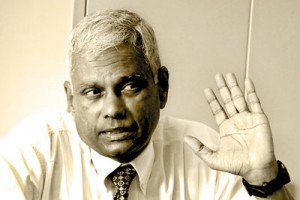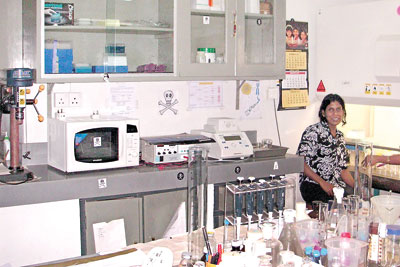News
Research on brain diseases: Lanka in front

The brain specimens in the Brain Bank at the Interdisciplinary Centre for Innovation in Biotechnology & Neuroscience of the Sri Jayewardenepura University. Pix by Indika Handuwala
Tiny red and blue-capped containers and several scientific publications in top international journals have placed Sri Lanka in a niche by itself.
With the world concentrating on that all-important ‘command centre’ of the central nervous system which governs everything we do, the Sri Jayewardenepura University’s Interdisciplinary Centre for Innovation in Biotechnology & Neuroscience has taken a lead in the race to shed light on the diseases that affect the human brain and what can be done to ward them off.
The first-ever ‘Brain Bank’ is what we are privy to glimpse, having been led down the stairs to a basement-room of the centre with its rows of red and blue-capped bottles and refrigerators. The centre is headed by Director Prof. Ranil de Silva who is also the Principal Investigator of the Genetic Diagnostic & Research Laboratory and Human Brain Tissue and DNA Repository of the Department of Anatomy.
Prof. de Silva and his team, working closely with several international partners, have come up with some interesting findings not only after looking at aging Sri Lankan brains but also those of Indians. Their forays into the pathways of brain research have shown that the burden of Alzheimer’s Disease (AD), both in Sri Lanka and India is on par with the west. They have also identified possible genetic biomarkers (genes) which may indicate a pre-disposition towards brain diseases such as dementia, stroke and cerebral small vessel disease. The international partners were from India, South Korea, Australia and the Netherlands.
The possible brain protective effects of the frequent consumption of pure black tea and moderate consumption of green-yellow vegetables have also come forth through these doctoral research studies of Dr. Printha Kentheeswaran Wijesinghe, while indicating that meditation may have a positive effect on brain health.
“With evidence that such natural products are neuroprotectors, it could be a stepping-stone in developing a neutraceuticals-based industry in Sri Lanka for healthy brain aging,” urges Prof. de Silva.
These findings are crucial in the light of one new case of dementia being diagnosed every four seconds around the world and stroke killing every six seconds, someone, somewhere, regardless of age or gender, across the world. “After the age of 65, 1 in 4 men and 1 in 3 women are at risk of developing a stroke or dementia or both,” reminds Prof. de Silva, explaining that through their research, the first-ever brain autopsy study undertaken in South Asia, they explored the vascular and vascular genetic risk factors and cerebrovascular pathologies.

Prof. Ranil de Silva
So the simple take home message from Prof. de Silva especially to the younger generation is to have healthy, natural food such as vegetables, fruits and black or green tea and keep away from junk food. “Use your brain actively, indulging in mathematics or reading to keep AD at bay, for now we have proof through our research.”
Working in tandem Dr. K. Sunil Kumara of the Colombo South (Kalubowila) Teaching Hospital’s Judicial Medical Office, it was Printha as part of Prof. de Silva’s team who spent long hours at the hospital observing autopsies, gathering information from the relatives of the deceased and with her eye to the microscope, scrutinising slides back at the university.
While surmising that most probably, this research over four long years, is the biggest brain study worldwide and verily so in the region, Prof. de Silva details how both cadaveric blood and brain specimens were screened and scrutinised after noting down case histories and talking to relatives about the deceased patients’ lifestyles.
“Postmortem biopsies are the gold standard,” he points out, explaining that very early on he felt that the diseases which affect the brain such as stroke and dementia could be due to cardiovascular disease (CVD) risk factors. “I foresaw the necessity for my team to delve into this type of research, at a time when there were only few scientific articles. We have got our credentials right.”
Thus the team’s hard work has now borne fruit with top journals picking up their findings and also billing Prof. de Silva as a speaker at widely-attended conferences.

Dr. Printha Kentheeswaran Wijesinghe in the laboratory
The latest research emanating from the centre titled ‘Vascular Contributions in Alzheimer’s Disease-Related Neuropathological Changes: First Autopsy Evidence from a South Asian Aging Population’ and ‘Cytoskeletal Pathologies of Age-Related Diseases between Elderly Sri Lankan (Colombo) and Indian (Bangalore) Brain Samples’ have very recently been published in the reputed ‘Journal of Alzheimer’s Disease’ (Impact Factor 4.15) ranked the 68th of 256 journals on Neurosciences and the ‘Current Alzheimer Research’(Impact Factor 3.933) ranked as the 34th of 192 journals on Clinical Neurology and 69th of 256 journals on Neurosciences worldwide respectively.
Back in 2006, the World Scientific Press based in London, United Kingdom, had published the ‘Therapeutic Applications of Ceylon Tea: Potential and Trends’ and in 2008, the Journal of Chinese Pharmaceutical Sciences, the ‘Therapeutic effects of flavonoids from Ceylon green tea on hypoxic human brain epithelial cells’.
Prof. de Silva, meanwhile, representing his team, will speak on ‘Banking the brain and blood: A Sri Lankan emerging era of collaborative research — what the East can offer the West’ at Neuroscience 2016, the 46th annual meeting of the Society for Neuroscience from November 12-16 in San Diego, California, United States of America and ‘Culture and lifestyle factors in cognitive screening and neuropathology of aging: A South Asian experience’ at the World Federation of Neurology Research on Dementia Group at the Conference on ‘Brain Aging and Dementia in Developing Countries’ in Nairobi from December 6-9.
He has already held up the local model during a lecture he delivered at the 34th Annual Meeting of the Indian Academy of Neurosciences at the National Brain Research Centre, Manesar, India from October 19-21, which had been picked up by the prestigious Times of India and Hindustan Times. Last year, he had given a round of talks in China.
| Lifestyles of dead patients gathered from relatives They gently spoke to the relatives of the deceased patients, getting an insight into what these people ate and drank and how they lived. They also screened the blood of these patients and took specimens of their brains after the autopsies in their quest to gather elusive knowledge on what is affecting the aging brain. They were looking for neurodegenerative and stroke pathologies in 76 Sri Lankan and 50 Indian human brain samples, using molecular genetic techniques. The diligent team from the Sri Jayawardanapura University’s Interdisciplinary Centre for Innovation in Biotechnology & Neuroscience under the guidance of Prof. Ranil de Silva performed histopathological/immunohistochemical staining on the 76 autopsy aging brain samples to get a hold of the complex neuropathology of seven diseases. They also conducted grain pathology through genotyping for selective candidate genes. “We have stored these samples in our Brain Bank,” says Prof. de Silva, profiling the deceased patients as being in the age-range of 50-89 years, with the median age being 65.5 years. The group includes 52 men and 24 women. The final autopsy diagnosis included 45 with cardiovascular diseases; two with coronary obstructive airway disease; six through suicide; seven due to accidents; three from pneumonia; one from asphyxia; two from cancer; one from cirrhosis of the liver; three from septicaemia/ septic shock; two from protracted complicated illness; and four from unknown causes. The team in collaboration with the National Institute of Mental Health & Neurosciences, Bangalore, India, was also able to put under the microscope the Indian aging brains. And under scrutiny were Alzheimer’s Disease (AD), Parkinson Disease, Progressive Supranuclear Palsy, Dementia with Lewy Bodies, Multiple System Tauopathy with Dementia, Cerebral Amyloid Angiopathy and Argyrophilic Grain Disease. The findings are: *The burden of AD-related neuropathology in Sri Lanka and India was similar to that of the west. This is at variance with expected lower AD-related lesion burden based on the clinical/epidemiological studies suggesting lower prevalence in these countries. *The possible protective effects of frequent consumption of pure black tea (≥4cups/day) and moderate consumption of green-yellow vegetables in dementia-related neuropathological changes. This indicates that diet could play a role towards healthy brain aging. *The confirmation of the strong contribution of hypertension and diabetes in stroke and the strong association of cerebral small vessel lesions in AD-related neuropathological changes. Oxidative stress might be an important contributor to cerebral small vessel disease (SVD), a major contributor to stroke and a leading cause of cognitive impairment and dementia. *Experimental studies in using natural anti-oxidants such as the polyphenol anti-oxidant, catechin (from green tea), are promising. * A strong association between illiteracy (less than primary education) and increased risk of brain degeneration. * Having investigated, in collaboration with Dr. Lochandaka Ranathunga of the Department of Information Technology, Faculty of Information Technology, University of Moratuwa, the wave-pattern variations of people who have engaged in meditation long-term, the study had found that meditation has a mind-relaxing effect. However, further studies may be needed to confirm this. A trend indicative that those with brain diseases such as dementia which affect cognitive status were more likely to commit suicide or die in traffic accidents and as such forensic autopsies should include neuropathological examination of the brains of such elderly victims. Police records which state that the highest percentage of suicides is in the 70-age group, therefore, corroborate the centre’s findings.
|

